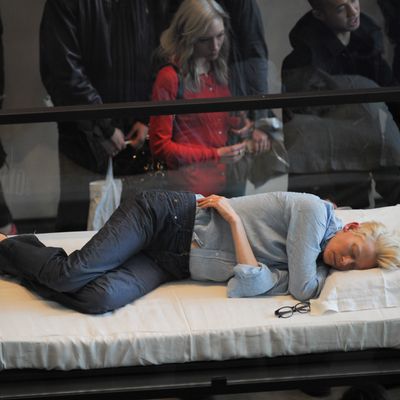
Placing living art in MoMAÔÇÖs airy atrium has become the museumÔÇÖs crystal meth. The addiction kicked in big-time a few seasons back when Marina Abramovic, the self-styled mystic guru of staring and making people cry just by looking in their eyes, sat in the museumÔÇÖs atrium for months as people lined up for the chance to sit across from her and say they were part of the art. It was a spacey, necromantic circus. Upstairs, her audiences packed the galleries so they could walk between naked men and women standing in doorways (ÔÇ£his penis brushed my thighÔÇØ) or gawk at a woman high on a wall, naked, astride a bicycle seat (ÔÇ£ouchÔÇØ). A whole movie was made based on the months-long pageant.
MoMA has produced a few knockoffs of the strategy since then. The artist Martha Rosler organized her own yard sale inside the museum. (Prices and attendees were more East Hampton than upstate.) The ÔÇ£exchangeÔÇØ or ÔÇ£experienceÔÇØ for viewers in this piece was the interaction with the artist herself. Artist as medium and magician of Earth, live in the museum. It was a big hit, too, and even aped traditional art insofar as just by having Rosler present, people were hyped enough to pay way more than they should have for trinkets and whatnot. But thatÔÇÖs the ancient alchemy of art packaged, theatricalized, theorized, monetized, and made easy at the same time.
Before the indoor yard sale, there was the similarly popular success of Allora and CalzadillaÔÇÖs atrium performances, featuring a grand piano with a hole in it that was played by one of a number of musicians, each giving his or her own rendition of BeethovenÔÇÖs Ode to Joy while the instrument rolled around the room. Another one ÔÇö and I fell hard for it ÔÇö was Pipilotti RistÔÇÖs video, which didnÔÇÖt feature any live bodies but became such a smash that the space was filled with people at all times, lying on the floor, resting on couches, sitting against walls, just drifting to blissful hallucinogenic images and music as one mind. What wasnÔÇÖt to love? This was the museum as town square and transporter at the same time.
Elsewhere, I swooned for Tino SehgalÔÇÖs live performers taking us up the GuggenheimÔÇÖs ramp. And twenty years ago, Coco Fusco and Guillermo G├│mez-Pe├▒a spent weeks in a cage, dressed as Native Americans, as part of the 1993 Whitney Biennial. So none of this is anything especially new.
But at MoMA, itÔÇÖs become the default. Over the weekend, in the latest twist on whatever-it-takes to get them in the doors while presumably showing a little intellectual leg, Tilda Swinton napped inside a glass case just off the museumÔÇÖs atrium. ItÔÇÖs a re-performance of Cornelia ParkerÔÇÖs ÔÇ£The MaybeÔÇØ which Swinton will be doing from time to time, unannounced, six more times. ItÔÇÖs cute thinking: The museum has figured out a way to turn a snoozefest into spectacle. (And without using James Franco.) This weekend, the place (not to mention Twitter) was abuzz, not just with the live-body-in-a-box business but also with the up-close, personal, even a little sexy idea of seeing a movie star asleep or feigning sleep. We got to gawk at stardom like a specimen in a box. It sure doesnÔÇÖt hurt that SwintonÔÇÖs aura is fabulously complex, sexual, asexual, mysterious, powerful, impish. I imagine if you or I tried it, people wouldÔÇÖve thrown gum wrappers in the box and tapped on the glass. Not here: According to reports, it was as if people were beholding an Egyptian mummy come to semi-somnambulant life. ÔÇ£Oh, she twitched!ÔÇØ ÔÇ£SheÔÇÖs breathing.ÔÇØ ÔÇ£Oh my God! Is that that movie star!?ÔÇØ ItÔÇÖs the opposite of ProustÔÇÖs private cork-lined bedroom to keep the world out. This is MoMA signing on for the full star treatment.
IÔÇÖm a sourpuss, so I think this is just a hokey artsy strategy to disguise the fact that the place doesnÔÇÖt have enough room to show its tremendous collection. Visiting there now is unpleasant because the museum has been so overcrowded since its 2004 makeover. The event also has inner content: MoMA is narcissistically puffing its celebrity feathers, playing at being avant-garde. And then the atrium itself is a problem: ItÔÇÖs such a weirdly proportioned disembodied non-space that almost all efforts to hang traditional artworks there have been a bust. (A horrifying low point was the reduction of MonetÔÇÖs water-lily paintings to travel posters in the soaring concrete and stone.)
On the other hand, itÔÇÖs fine that MoMA and Tilda Swinton have a jones for being looked at, being risqu├®, and being fun. Even better is the wonderful possibility that museum visitors might come here, see a movie star asleep in a case, accept it as some kind of art, get super excited, and wonder how on Earth something this strange got started. And theyÔÇÖd rush upstairs to the greatest collection of modern art in the world, let themselves go, and add their thinking to the group mind.

